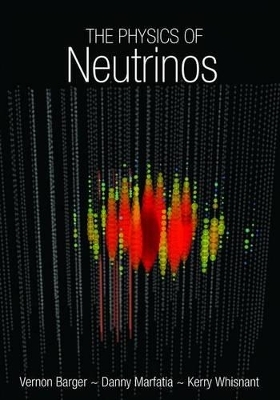
The Physics of Neutrinos
Princeton University Press (Verlag)
978-0-691-12853-5 (ISBN)
The physics of neutrinos--uncharged elementary particles that are key to helping us better understand the nature of our universe--is one of the most exciting frontiers of modern science. This book provides a comprehensive overview of neutrino physics today and explores promising new avenues of inquiry that could lead to future breakthroughs. The Physics of Neutrinos begins with a concise history of the field and a tutorial on the fundamental properties of neutrinos, and goes on to discuss how the three neutrino types interchange identities as they propagate from their sources to detectors. The book shows how studies of neutrinos produced by such phenomena as cosmic rays in the atmosphere and nuclear reactions in the solar interior provide striking evidence that neutrinos have mass, and it traces our astounding progress in deciphering the baffling experimental findings involving neutrinos. The discovery of neutrino mass offers the first indication of a new kind of physics that goes beyond the Standard Model of elementary particles, and this book considers the unanticipated patterns in the masses and mixings of neutrinos in the framework of proposed new theoretical models.
The Physics of Neutrinos maps out the ambitious future facilities and experiments that will advance our knowledge of neutrinos, and explains why the way forward in solving the outstanding questions in neutrino science will require the collective efforts of particle physics, nuclear physics, astrophysics, and cosmology.
Vernon Barger is professor of physics at the University of Wisconsin-Madison. He is the coauthor of Collider Physics. Danny Marfatia is associate professor of physics at the University of Kansas. Kerry Whisnant is professor of physics at Iowa State University.
Preface xi 1 Introduction 1 2 Neutrino Basics 11 2.1 Dirac and Majorana Neutrinos 11 2.2 Neutrino Counting 12 2.3 Neutrinos from Weak Decays 14 2.4 Neutrino Cross Sections 16 2.5 Neutrino Detectors 24 2.6 Neutrino Beams 28 3 Neutrino Mixing and Oscillations 33 3.1 Vacuum Oscillations 33 3.2 Matter Effects on Oscillations 36 3.3 Solar Neutrino Oscillations 38 3.4 Long-baseline Oscillations through the Earth 41 3.5 Matter Effects for Sterile Neutrinos 42 3.6 Decoherence 43 4 Solar Neutrinos 45 4.1 Origin of Solar Neutrinos 45 4.2 Solar Neutrino Experiments 46 4.3 KamLAND 49 4.4 Solar/Reactor Neutrino Parameters 49 4.5 Flux-independent Tests 53 4.6 Future Experiments 56 4.7 Geoneutrinos 57 5 Atmospheric Neutrinos 59 5.1 Atmospheric Neutrino Experiments 59 5.2 Matter Effects for Atmospheric Neutrinos 63 5.3 Long-baseline Neutrino Experiments 64 6 Global Three-neutrino Fits 68 7 Absolute Neutrino Mass 71 7.1 Beta Decay 71 7.2 Cosmological Limits 72 7.3 Neutrinoless Double-beta Decay 73 8 Long-baseline Neutrino Oscillations 76 8.1 Conventional Neutrino Beams 77 8.2 Reactor Experiments 80 8.3 Superbeams 85 8.4 Neutrino Factories 87 8.5 Beta Beams 91 8.6 Comparing Long-baseline Experiments 92 8.7 T and CPT Symmetries 97 9 Model Building 99 9.1 The Seesaw Mechanism 99 9.2 Patterns of Neutrino Masses and Mixings 102 9.3 GUT Models 105 9.4 Non-GUT-specific Models 107 9.5 Leptogenesis 114 10 Supernova Neutrinos 116 10.1 General Description of a Supernova 116 10.2 Neutrino Fluxes from the SN Core 118 10.3 Flavor Swapping from Collective Effects 119 10.4 MSW Conversions in a Supernova 120 10.5 Detection of Supernova Neutrinos 122 10.6 Supernova Relic Neutrinos 124 11 High-energy Astrophysical Neutrinos 126 11.1 Cosmogenic Neutrinos 126 11.2 IceCube 128 11.3 Waxman-Bahcall Flux 132 11.4 Ultra High-energy Neutrino Cross Sections 133 11.5 Z-burst Mechanism 134 11.6 Astrophysical Neutrino Flavor Content 135 11.7 Neutrinos from Dark Matter Annihilation 138 12 Beyond Three Neutrinos 147 12.1 LSND Experiment 147 12.2 MiniBooNE Experiment 152 12.3 Mass-varying Neutrinos 158 12.4 Neutrino Decay 161 12.5 Neutrino Decoherence 163 12.6 Lorentz Invariance Violation 164 12.7 Non-standard Neutrino Interactions 166 12.8 Heavy Majorana Neutrinos at Colliders 169 12.9 Neutrino Magnetic Moment 170 12.10 Fourth Generation Neutrino 171 13 Summary and Outlook 172 References 177 Index 221
| Zusatzinfo | 27 halftones. 51 line illus. |
|---|---|
| Verlagsort | New Jersey |
| Sprache | englisch |
| Maße | 178 x 254 mm |
| Gewicht | 567 g |
| Themenwelt | Naturwissenschaften ► Physik / Astronomie ► Astronomie / Astrophysik |
| Naturwissenschaften ► Physik / Astronomie ► Atom- / Kern- / Molekularphysik | |
| Naturwissenschaften ► Physik / Astronomie ► Hochenergiephysik / Teilchenphysik | |
| Naturwissenschaften ► Physik / Astronomie ► Quantenphysik | |
| ISBN-10 | 0-691-12853-7 / 0691128537 |
| ISBN-13 | 978-0-691-12853-5 / 9780691128535 |
| Zustand | Neuware |
| Haben Sie eine Frage zum Produkt? |
aus dem Bereich


